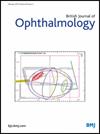Inflammation and patient satisfaction in micropulse versus continuous wave transscleral cyclophotocoagulation.
IF 3.7
2区 医学
Q1 OPHTHALMOLOGY
引用次数: 0
Abstract
BACKGROUND/AIMS This work aims to clarify whether micropulse transscleral cyclophotocoagulation (MPCPC) is gentler in terms of postoperative inflammation and is better tolerated compared with continuous wave cyclophotocoagulation (CWCPC). METHODS Prospective, randomised controlled, interventional, single-centre trial performed at the Ludwig Maximilians University Munich from January 2020 to July 2023. In all patients, a laser flare meter was used to measure anterior chamber flare (ACF). Central macular thickness (CMT) was assessed using optical coherence tomography. To quantify pain perception and quality of life (QoL), patients completed the Visual Analogue Scale (VAS) and the Glaucoma Activity Limitation 9 questionnaire. RESULTS 60 eyes of 60 patients were included, with 30 eyes in the MPCPC group and 30 eyes in the CWCPC group. A significantly higher increase in ACF was found after CWCPC as compared with MPCPC at 1 day (p=0.004) and 1 week after surgery (p=0). ACF values equalised at week 6 (p=0.270) and month 3 (p=0.610). The increase in ACF at week 1 did not show a significant correlation with the final decrease in intraocular pressure (IOP, p=0.465). Moreover, the CWCPC group showed a markedly higher increase in CMT (165.5 (15-354) µm vs 55.8 (24-141) µm). VAS and QoL scores did not show to be significantly different. CONCLUSIONS Compared with MPCPC, patients treated with CWCPC presented with more marked ACF only in the early postoperative period. ACF did not correlate with final IOP. CWCPC and MPCPC are equally well tolerated in terms of pain perception and QoL, but CWCPC may cause more severe inflammatory macular oedema.微脉冲与连续波经巩膜光凝治疗的炎症和患者满意度。
背景/目的本研究旨在阐明微脉冲经巩膜循环光凝(MPCPC)是否比连续波循环光凝(CWCPC)在术后炎症方面更温和,耐受性更好。方法:前瞻性、随机对照、干预性、单中心试验于2020年1月至2023年7月在慕尼黑路德维希马克西米利安大学进行。所有患者均使用激光耀斑仪测量前房耀斑(ACF)。采用光学相干断层扫描评估中央黄斑厚度(CMT)。为了量化疼痛感觉和生活质量(QoL),患者完成了视觉模拟量表(VAS)和青光眼活动限制问卷。结果纳入60例患者60眼,其中MPCPC组30眼,CWCPC组30眼。术后1天(p=0.004)和术后1周(p=0), CWCPC术后ACF明显高于MPCPC。ACF值在第6周(p=0.270)和第3个月(p=0.610)时相等。第1周ACF升高与最终眼压下降无显著相关性(IOP, p=0.465)。此外,CWCPC组的CMT显著增加(165.5(15-354)µm vs 55.8(24-141)µm)。VAS和QoL评分差异无统计学意义。结论与MPCPC相比,CWCPC患者仅在术后早期出现更明显的ACF。ACF与最终IOP无相关性。CWCPC和MPCPC在疼痛感觉和生活质量方面同样具有良好的耐受性,但CWCPC可能导致更严重的炎症性黄斑水肿。
本文章由计算机程序翻译,如有差异,请以英文原文为准。
求助全文
约1分钟内获得全文
求助全文
来源期刊
CiteScore
10.30
自引率
2.40%
发文量
213
审稿时长
3-6 weeks
期刊介绍:
The British Journal of Ophthalmology (BJO) is an international peer-reviewed journal for ophthalmologists and visual science specialists. BJO publishes clinical investigations, clinical observations, and clinically relevant laboratory investigations related to ophthalmology. It also provides major reviews and also publishes manuscripts covering regional issues in a global context.

 求助内容:
求助内容: 应助结果提醒方式:
应助结果提醒方式:


